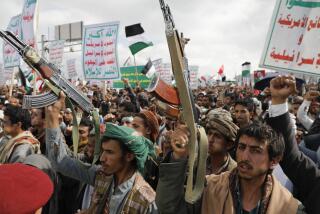Navy’s New Hornet Carries a Bigger Sting Than Predecessor
- Share via
ABOARD THE CARRIER ABRAHAM LINCOLN, off Southern California--On the flight deck above, the Navy’s newest warplane, the F/A-18E Super Hornet, is landing with the thunderous thump that befits its 34,000 pounds.
Below decks, in the ready room of squadron VFA115, Cmdr. Jeff Penfield explains what the Super Hornet will take to the fight compared to other U.S. aircraft: “More lethality.”
Bigger, heavier and more expensive than the original Hornets that joined the fleet in the early 1980s, the Super Hornets are built to carry more bombs and more missiles and have what aviators call “longer legs.”
With larger fuel tanks, the Super Hornet can fly farther without refueling than the earlier version and can “loiter” longer over targets waiting for bombing assignments to be coordinated. Super Hornets also can act as refueling tankers, a first for a strike fighter aircraft.
After a decade of research and development, and after overcoming aeronautic problems and political opposition, the Super Hornet finally is deemed ready for combat, the Navy’s first new fighter design in nearly two decades.
As the Lincoln and its battle group head toward an uncertain mission in the Persian Gulf and Arabian Sea, the 12 Super Hornets in Penfield’s squadron, which is based at the Naval Air Station at Lemoore, Calif., are the first to be deployed to a war zone.
“A lot of people are looking at us, wondering if we’ll fall on our faces,” said Cmdr. Dale Horan, the squadron’s executive officer. “The airplane has proven itself. Now it’s up to us to show what we’re capable of.”
The Super Hornet could be considered the aviation equivalent of the sports-utility vehicle: a large, pricey conveyance that gives away some speed and maneuverability in exchange for enhanced mission capabilities and greater protection in case of a mishap.
Boosters say it has the dogfighting ability of the F-14 Tomcat, greater bombing punch than the early Hornet, the midair refueling capability of the S-3 Viking and, with some tweaking, the electronic warfare function of the AE-6B Prowler.
Still, critics are concerned that the single-seat Super Hornet design may leave pilots “overtasked” by the complexities of handling the new and sophisticated systems, particularly during the high stress of combat. (A two-person version of the Super Hornet, the F/A-18F, is being tested by other squadrons.)
“They say it takes 1.8 persons to fly a Super Hornet, but there’s only one of us in the plane,” said Lt. Rob Kihm aboard the Lincoln. “The goal is to be on top of everything when you’re in the cockpit.”
Navy brass believe the Super Hornet is the combat workhorse of the future, at least until the Joint Strike Fighter being built for the Navy, Air Force and Marine Corps is delivered late this decade or early in the next.
Vice Adm. John Nathman, commander of Naval Air Force, Pacific Fleet, said the Super Hornet brings “quantum improvements” in range, payload and the ability to “strike targets deep in-country,” like those in Afghanistan.
With the increasing difficulty of convincing foreign countries to allow the U.S. to base planes on their soil, the longer-range Super Hornet will be able to reach targets from a carrier, Nathman said.
Innovation does not come cheaply. At $57 million each, the Super Hornet is nearly double the cost of the earlier version. (The Marine Corps, which flies the Hornet, decided that the Super Hornet was too expensive.)
Boeing Co. has a contract to build 222 Super Hornets for the Navy at its St. Louis plant, with the possibility of 300 more, although Defense Secretary Donald H. Rumsfeld is considering trimming the order as a cost-cutting measure.
The main subcontractor, Northrop Grumman Corp., has 1,500 employees at its El Segundo plant working on Super Hornets. Raytheon Co. in El Segundo has 200 workers providing the radar and targeting technology.
The goal is for the Super Hornet to replace the aging Tomcats and Hornets.
The new plane’s increased size--taller, longer, wider and 8,000 pounds heavier than the “heritage” Hornets--has earned it the nickname Rhino. It does not have the top-end speed of the Hornet, not to mention the super-fast Tomcat, the Tom Cruise plane from the movie “Top Gun.”
“I miss that [the Tomcat speed], I’ll be honest with you,” said Horan, a former F-14 pilot. “But tactics are such I should never get in that situation where I need that extra speed.”
Any drop-off in speed, Super Hornet pilots say, is more than compensated by other improvements in the plane.
“A short guy with a gun beats a big guy with a knife,” said Cmdr. Brian Gawne. “The ability to point your nose and shoot in the Super Hornet is unmatched.”
More to Read
Sign up for Essential California
The most important California stories and recommendations in your inbox every morning.
You may occasionally receive promotional content from the Los Angeles Times.










